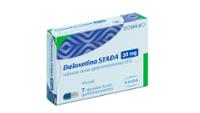

Duloxetina stada 30 mg capsulas duras gastrorresistentes efg


Інструкція із застосування Duloxetina stada 30 mg capsulas duras gastrorresistentes efg
Введение
Противорецептор: информация для пользователя
Дулоксетина STADA30мг жёсткие гастрорезистентные капсулыEFG
Читайте всю инструкцию внимательно, прежде чем начать принимать этот препарат, потому что она содержит важную информацию для вас.
-Сохраните эту инструкцию, поскольку может потребоваться повторно прочитать ее.
-Если у вас есть какие-либо вопросы, обратитесь к вашему врачу или фармацевту.
-Этот препарат был назначен только вам и не следует давать его другим людям, даже если у них есть те же симптомы, что и у вас, поскольку это может причинить вред.
-Если у вас появляются побочные эффекты, обратитесь к вашему врачу или фармацевту, даже если это побочные эффекты, которые не указаны в этой инструкции. См. раздел 4.
1.Что такоеДулоксетина Stada и для чего она используется
2.Что нужно знать перед началом приемаДулоксетина Stada
3.Как принимать Дулоксетина Stada
4.Возможные побочные эффекты
5.Хранение Дулоксетина Stada
6.Содержимое упаковки и дополнительная информация
1. Что такое Дулоксетина Стада и для чего она используется
Дулоксетина Стада содержит активное вещество дулоксетина. Дулоксетина увеличивает уровни серотонина и норадреналина в нервной системе.
Дулоксетина используется у взрослых для лечения:
•депрессии
•общей аффективной тревоги (хроническая чувство тревоги или нервозности)
•диабетического невропатического боли (часто описывается как жжение, колющая боль, как уколы, зуд, или как электрический спазм. Могут быть потеря чувствительности в пораженной области, или может произойти боль при прикосновении к зоне или при контакте с теплом, холодом или давлением).
Дулоксетина начинает действовать у большинства людей с депрессией или тревогой через две недели после начала лечения, но может пройти от 2 до 4 недель, прежде чем человек начнет чувствовать себя лучше. Обратите внимание врача, если не замечает улучшения в течение этого времени. Врач может продолжать давать дулоксетину, когда человек чувствует себя лучше, чтобы предотвратить возвращение депрессии или тревоги.
У людей с диабетическим невропатическим болью может пройти несколько недель, прежде чем они начнут чувствовать себя лучше. Обратитесь к врачу, если не чувствуете себя лучше через 2 месяца.
2. Что нужно знать перед началом приема Duloxetina Stada
Не принимайте Duloxetina Stada:
-если вы аллергины на дулокситин или на любые другие компоненты этого препарата (включая те, которые перечислены в разделе 6)
-у вас есть печеночная недостаточность
-у вас есть тяжелая почечная недостаточность
-вы принимаете или недавно принимали в течение последних 14 дней другой препарат, известный как ингибитор моноаминоксидазы (ИМАО) (см. «Другие препараты и Duloxetina Stada»)
-вы принимаете флуоксетин, который обычно используется для лечения депрессии, ципрофлоксацин или эноксацин, которые используются для лечения некоторых инфекций
-вы принимаете другие препараты, содержащие дулокситин (см. «Другие препараты и Duloxetina Stada»).
Обратитесь к врачу, если у вас высокое кровяное давление или сердечная болезнь. Врач решит, следует ли вам принимать дулокситин.
Предупреждения и предостережения
Дулокситин может не быть подходящим для вас по следующим причинам.Обратитесь к врачу перед началом приема этого препаратаесли:
-вы используете другие препараты для лечения депрессии (см. «Другие препараты и Duloxetina Stada»)
-вы принимаете Hierba de San Juan, травяной препарат (Hypericum perforatum)
-у вас есть какие-либо заболевания почек
-вы перенесли судороги (эпилептические припадки)
-вы перенесли манию
-у вас есть биполярное расстройство
-у вас есть проблемы с глазами, такие как некоторые виды глаукомы (повышенное внутриглазное давление)
-вы перенесли кровотечения (склонность к образованию гематом), особенно если вы беременны (см. «Беременность, грудное вскармливание и фертильность»).
-у вас есть риск низкого уровня натрия (например, если вы принимаете диуретики, особенно если вы старше)
-вы проходите лечение с другими препаратами, которые могут нанести вред печени
-вы принимаете другие препараты, содержащие дулокситин (см. «Другие препараты и Duloxetina Stada»)
Дулокситин может вызвать чувство беспокойства или неспособность оставаться сидящим или спокойным. Если это происходит, сообщите об этом врачу.
Также свяжитесь с врачом:
Если вы испытываете признаки и симптомы беспокойства, галлюцинаций, потери координации, быстрого сердцебиения, повышения температуры тела, быстрого изменения артериального давления, гиперрефлексии, диареи, комы, тошноты, рвоты, поскольку вы можете страдать от синдрома серотонинового выброса.
В своей наиболее тяжелой форме синдром серотонинового выброса может напоминать синдром нейролептического маниакального психоза (СНМП). Признаки и симптомы СНМП могут включать комбинацию повышенной температуры, быстрого сердцебиения, потоотделения, тяжелой мышечной rigidity, бессознательности, повышения мышечных ферментов (определенных с помощью анализа крови).
Некоторые препараты группы, к которой принадлежитDuloxetina Stada(называемые IRSN), могут вызвать симптомы дисфункции половой сферы (см. раздел 4). В некоторых случаях эти симптомы сохраняются после прекращения лечения.
Мышления о самоубийстве и ухудшение депрессии или тревожного расстройства
Если вы чувствуете себя подавленным и/или страдаете тревожным расстройством, вы можете иногда иметь мысли о самоубийстве. Эти мысли могут усиливаться в начале лечения с антидепрессантами, поскольку все эти препараты требуют некоторого времени, чтобы проявить свое действие, обычно две недели, но иногда и дольше. Вам более вероятно будет иметь такие мысли, если:
-вы ранее имели мысли о самоубийстве
-вы молоды. Есть информация, полученная из клинических испытаний, которая показывает повышенный риск суицидального поведения у взрослых моложе 25 лет, страдающих психическим расстройством и принимающих антидепрессанты.
Свяжитесь с врачом или обратитесь напрямую в больницу в тот момент, когда у вас появляются какие-либо мысли о самоубийстве.
Может быть полезно рассказать о своих проблемах с депрессией или тревожным расстройством близкому вам человеку и попросить его прочитать этот листок. Вы можете попросить их сказать вам, если они замечают, что ваша депрессия или тревожное расстройство ухудшаются, или если они обеспокоены изменениями в вашем поведении.
Дети и подростки
Дулокситин обычно не следует использовать у детей и подростков моложе 18 лет. Кроме того, пациенты моложе 18 лет, принимающие эту группу препаратов, имеют повышенный риск развития побочных эффектов, таких как попытки самоубийства, мысли о самоубийстве и агрессивность (преимущественно агрессивное поведение, противоречивое поведение и гнев). Хотя это так, ваш врач может назначить дулокситин пациентам моложе 18 лет, если решит, что это будет полезно для пациента. Если ваш врач назначил дулокситин пациенту моложе 18 лет и вы хотите поговорить об этом, пожалуйста, вернитесь к врачу. Вы должны сообщить врачу, если у пациентов моложе 18 лет появляются или ухудшаются симптомы, перечисленные выше. Кроме того, в этом возрасте еще не изучены долгосрочные последствия безопасности дулокситина, связанные с ростом, развитием и развитием когнитивных и поведенческих функций.
Другие препараты и Duloxetina Stada
Обратите внимание врача или фармацевта, если вы принимаете, недавно принимали или, возможно, будете принимать любой другой препарат.
Основной компонент Duloxetina Stada, дулокситин, используется в других препаратах для других лечений:
•диабетическая невропатическая боль, депрессия, тревожное расстройство и недержание мочи
Должно быть избегано использование более одного из этих препаратов одновременно. Проверьте с врачом, если вы уже используете другие препараты, содержащие дулокситин.
Врач решит, можно ли вам принимать Duloxetina Stada с другими препаратами.Не начинайте или не прекращайте принимать любой препарат, включая те, которые вы покупаете без рецепта и травяные препараты, без консультации с врачом.
Также сообщите врачу, если вы принимаете любой из следующих препаратов:
Ингибиторы моноаминоксидазы (ИМАО):не принимайте дулокситин, если вы принимаете или недавно принимали другой препарат, известный как ингибитор моноаминоксидазы (ИМАО). Например, ИМАО включают в себя моклобемид (антидепрессант) и линезолид (антибиотик). Принимая ИМАО вместе с многими лекарствами, назначенными врачом, включая дулокситин, может вызвать серьезные побочные эффекты, даже угрожающие жизни. Должно быть подождать не менее 14 дней после прекращения лечения ИМАО, чтобы принять дулокситин. Аналогично, должно быть подождать не менее 5 дней после прекращения лечения дулокситина, чтобы начать лечение ИМАО.
Препараты, вызывающие сонливость:Это включает в себя препараты, назначенные врачом, такие как бензодиазепины, сильные анальгетики, антипсихотические препараты, фенобарбитал и антигистаминные препараты.
Препараты, увеличивающие уровень серотонина: триптаны, тримадол, триптофан, ингибиторы селективной рекуперации серотонина (ИСС, такие как пароксетин и флуоксетин), IRSN (такие как венлафаксин), трициклические антидепрессанты (такие как кломипрамин, амитриптилин), петидин, Hierba de San Juan и ИМАО (такие как моклобемид и линезолид). Эти препараты увеличивают риск побочных эффектов; если вы замечаете любое редкое признаке, когда вы используете какой-либо из этих препаратов вместе с дулокситином, сообщите об этом врачу.
Оральные антикоагулянты или антиагреганты плетки:Препараты, разжижающие кровь или предотвращающие образование тромбов в крови. Эти препараты могут увеличить риск кровотечения.
ПринятиеDuloxetina Stada с пищей, напитками и алкоголем
Duloxetina Stada можно принимать с или без пищи. Должно быть осторожно, если вы принимаете алкоголь во время лечения дулокситином.
Беременность, грудное вскармливание и фертильность
Если вы беременны или на грудном вскармливании, если вы думаете, что можете быть беременны или если вы планируете беременность, обратитесь к врачу или фармацевту перед использованием этого препарата.
- Обратите внимание врача, если вы беременны или если вы пытаетесь забеременеть, пока вы находитесь в лечении дулокситином. Вы должны использовать дулокситин только после оценки с врачом потенциальных преимуществ и любого потенциального риска для плода.
- Убедитесь, что ваша акушерка и/или ваш врач знают, что вы принимаете дулокситин. Другие препараты, подобные ISRS, принимаемые во время беременности, могут увеличить риск развития серьезной болезни у новорожденных, называемой гипертензией пульмонарной перзистентной новорожденной (HPPRN), которая заставляет новорожденного дышать быстрее и получить синюшный оттенок. Эти симптомы обычно начинаются в первые 24 часа после рождения ребенка. Если это происходит у вашего ребенка, вы должны немедленно связаться с вашей акушеркой и/или врачом.
- Если вы принимаете дулокситин, когда приближается конец беременности, ваш ребенок может иметь некоторые симптомы при рождении. Обычно они начинаются в момент рождения или в первые дни после рождения ребенка. Среди этих симптомов могут быть слабые мышцы, дрожание, возбуждение, проблемы с кормлением, проблемы с дыханием и судороги. Если у вашего ребенка есть какие-либо из этих симптомов при рождении или если вы обеспокоены состоянием вашего ребенка, свяжитесь с врачом или акушеркой, которые могут вам помочь.
- Доступные данные о использовании дулокситина в течение первых трех месяцев беременности не показывают общее увеличение риска врожденных дефектов у ребенка. Если вы принимаете дулокситин во второй половине беременности, может быть повышенный риск того, что ребенок родится раньше срока (6 дополнительных случаев преждевременных родов из 100 женщин, принимающих дулокситин во второй половине беременности), особенно между 35 и 36 неделями беременности.
- Обратите внимание врача, если вы кормите грудью. Не рекомендуется использовать дулокситин во время грудного вскармливания. Попросите совета у врача или фармацевта.
Вождение и использование машин
Во время лечения дулокситином вы можете чувствовать сонливость или головокружение. Не водите или не управляйте инструментами или машинами, пока вы не узнаете, как дулокситин влияет на вас.
Duloxetina Stada содержит сахарозу
Этот препарат содержит сахарозу. Если ваш врач сказал вам, что у вас есть непереносимость к определенным сахарам, обратитесь к нему перед приемом этого препарата.
3. Как принимать Дулоксетину Стада
Следуйте точно указаниям по применению этого препарата, указанным вами врачом или аптекарем. В случае сомнений, обратитесь снова к врачу или аптекарю.
Доза
Для депрессии и диабетического невропатического боли:
Рекомендуемая доза дулокситина составляет 60 мг один раз в день, но ваш врач назначит вам дозу, которая лучше всего подходит для вас.
Для обобщенной анастетической тревоги:
Начальная нормальная доза дулокситина составляет 30 мг один раз в день, после чего большинство пациентов получают 60 мг один раз в день, но ваш врач назначит вам дозу, которая лучше всего подходит для вас. Дозу можно корректировать до 120 мг в день в зависимости от вашей реакции на дулокситин.
Форма выпуска
Дулокситин следует принимать перорально. Вы должны проглотить целую капсулу с водой.
Чтобы не забыть принимать дулокситин, может быть полезно принимать его в одно и то же время каждый день.
Продолжительность использования
Обратитесь к врачу, чтобы узнать, сколько времени вы должны принимать дулокситин. Не переставайте принимать дулокситин, или не изменяйте свою дозу без консультации с врачом. Важно лечить ваше заболевание правильно, чтобы помочь вам улучшиться. Если вы не лечите свое заболевание, оно может не исчезнуть и может стать более серьезным и сложным для лечения.
Если вы принимаете большеДулокситин Стада, чем следует
В случае передозировки или случайного приема, немедленно обратитесь к врачу или аптекарю или позвоните в Токсикологический информационный центр по телефону: 91.562.04.20, указав препарат и принятую дозу.
Среди симптомов, вызванных передозировкой, входят сонливость, кому, серотониновый синдром (редкая реакция, которая может вызвать чувство сильного счастья, сонливость, безволие, беспокойство, чувство опьянения, лихорадку, потоотделение или мышечную спasticity), судороги, рвоту и высокую частоту сердечных сокращений.
Если вы забыли принятьДулокситин Стада
Если вы забыли принять дозу, принимайте ее как только вспомните. Однако, если это время следующей дозы, пропустите пропущенную дозу и примите обычную дозу. Не принимайте двойную дозу, чтобы компенсировать пропущенные дозы. Не принимайте больше дулокситина, чем назначено вам в день.
Если вы прекращаете лечение сДулокситин Стада
НЕ переставайте принимать свои капсулы без консультации с врачом, даже если вы чувствуете себя лучше. Если ваш врач думает, что вы больше не нуждаетесь в приеме дулокситина, он или она скажет вам, чтобы вы уменьшили свою дозу в течение хотя бы 2 недель перед тем, как прекратить лечение.
Некоторые пациенты, которые внезапно прекратили лечение дулокситином, показали симптомы, такие как:
•головокружение, чувство мурашек, как уколы или чувство электрического тока (особенно в голове), нарушения сна (сильные сны, кошмары, неспособность спать), усталость, сонливость, чувство беспокойства или возбуждения, чувство тревоги, тошнота или рвота, дрожь, головные боли, мышечные боли, чувство раздражительности, диарея и чрезмерное потоотделение или головокружение.
Эти симптомы обычно не имеют значения и проходят через несколько дней, но если вы испытываете симптомы, которые вам не нравятся, обратитесь к врачу.
Если у вас есть какие-либо другие вопросы по использованию этого препарата, спросите у врача или аптекаря.
4. Возможные побочные эффекты
Частые побочные эффекты (могут повлиять на более чем 1 из 10 человек)
•головная боль, сонливость
•настроение (тошнота), сухость во рту
Побочные эффекты часто встречаются (могут повлиять на до 1 из 10 человек)
•потеря аппетита
•трудности с засыпанием, чувство возбуждения, снижение либидо, тревога, трудности или неспособность к оргазму, необычные сны
•головокружение, чувство замедленности, дрожь, онемение, включая онемение, зуд или жжение на коже
•зametennost',
•заметная блurredness
•звон в ушах (перцепция звуков в ухе, когда нет звуков снаружи)
•чувство бейсбольного сердца
•повышение артериального давления, краснота
•повышение количества храпов
•застойная задержка стула, диарея, боль в животе, рвота, жжение в животе или изжога, газы
•повышение потоотделения, высыпания (зуд)
•боль в мышцах, спазмы мышц
•боль при мочеиспускании, частое мочеиспускание
•трудности с достижением эрекции, изменения в эякуляции
•падения (в основном у людей пожилого возраста), усталость
•потеря веса
Детям и подросткам в возрасте до 18 лет с депрессией, лечившимся этим лекарством, случались снижение веса при начале приема этого лекарства. Через 6 месяцев лечения вес увеличился до уровней, аналогичных другим детям и подросткам того же возраста и пола.
Редкие побочные эффекты (могут повлиять на до 1 из 100 человек)
•воспаление гортани, вызывающее кашель
•мысли о самоубийстве, трудности с засыпанием, скрежет зубов, чувство дезориентации, отсутствие мотивации
•спазмы и неумышленные движения мышц, чувство беспокойства или неспособность оставаться сидящим или неподвижным, нервозность, трудности с концентрацией внимания, изменения в вкусе, трудности с контролем движений, например: отсутствие координации или неумышленные движения мышц, синдром беспокойных ног, низкое качество сна
•расширение зрачков (центр глаза)
•зametennost' или проблемы с зрением
•чувство головокружения или вертиго, боль в ухе
•быстрый и/или нерегулярный пульс
•обмороки, головокружение, чувство головокружения или обморока при вставании, холод в пальцах рук и/или ног
•спазмы гортани, кровотечение из носа
•рвота кровью, или черные каловые массы, гастроэнтерит, эрuctation, трудности с глотанием
•воспаление печени, которое может вызвать боль в животе и желтуху кожи или белой части глаз
•ночные поты, высыпания, холодные поты, чувствительность к солнечному свету, повышение склонности к кровотечениям
•застойная мышечная rigidity, спазмы мышц
•трудности или неспособность мочеиспускать, трудности с началом мочеиспускания, необходимость мочеиспускать ночью, необходимость мочеиспускать чаще, чем обычно, снижение потока мочи
•анормальные кровотечения из влагалища, аномальные менструальные периоды, включая обильные, болезненные, нерегулярные или затяжные менструации, редко - легкие или отсутствие менструаций, боль в яичках или яичках
•боль в груди, чувство холода, жажда, озноб, чувство тепла, нарушение походки
•повышение веса
Дулоксетина может вызывать эффекты, о которых вы можете не замечать, такие как повышение ферментов печени или уровня калия в крови, креатинфосфокиназы, сахара или холестерина.
Редкие побочные эффекты (могут повлиять на до 1 из 1 000 человек)
•грубые аллергические реакции, которые вызывают затруднение дыхания или головокружение с опуханием языка или губ, аллергические реакции
•снижение активности щитовидной железы, что может вызвать усталость или повышение веса
•дефицит жидкости, низкие уровни натрия в крови (в основном у пожилых людей; симптомы могут включать головокружение, слабость, дезориентацию, сон или чрезмерную усталость, тошноту или рвоту, более серьезные симптомы - обмороки, судороги или падения), синдром неадекватной секреции гормона антидиуретического гормона (SIADH).
•мысли о самоубийстве, мания (гиперактивность, ускоренное мышление и снижение потребности в сне), галлюцинации, агрессивность и гнев
•«Синдром серотонина» (редкая реакция, которая может вызвать чувство сильной радости, сонливость, неуклюжесть, беспокойство, чувство опьянения, лихорадку, потливость или мышечную rigidity), судороги
•повышение внутриглазного давления (глаукома)
•кашель, свист и отсутствие дыхания, которые могут сопровождаться высокой температурой
•воспаление рта, красная кровь в кале, плохой запах изо рта, воспаление толстой кишки (что приводит к диарее)
•панкреатит, желтуха кожи или белой части глаз (ictericia)
•синдром Стивенса-Джонсона (груба болезнь с образованием пузырей на коже, в рот, глаза и гениталии), серьезные аллергические реакции, которые вызывают опухание лица или гортани (ангиоэдема)
•сжатие мышцы челюсти
•необычный запах мочи
•синдром менопаузы, аномальная лактация у мужчин или женщин
Очень редкие побочные эффекты (могут повлиять на до 1 из 10 000 человек)
•воспаление кровеносных сосудов на коже (васкулит кожи)
Неточная частота (не может быть оценена на основе доступных данных)
• знаки и симптомы заболевания, называемого «миокардитой от стресса», который может включать боль в груди, затруднение дыхания, головокружение, обмороки и нерегулярные пульсы.
Сообщение о побочных эффектах
Если вы испытываете любой тип побочного эффекта, обратитесь к врачу или фармацевту, даже если это возможные побочные эффекты, которые не указаны в этом листе информации. Вы также можете сообщить их напрямую через Систему испанского фармаковигиланса лекарств для человека: https://www.notificaram.es. Сообщение о побочных эффектах может помочь предоставить более подробную информацию о безопасности этого лекарства.
5. Консервация Дулоксетина Стада
Храните этот препарат вне видимости и доступа детей.
Не используйте этот препарат после даты окончания срока годности, указанной на упаковке, после CAD. Дата окончания срока годности — последний день месяца, указанного.
Этот препарат не требует специальной температуры хранения.Храните в оригинальной упаковке для защиты от влажности.
Препараты не следует выбрасывать через канализацию или в мусор. Отдавайте упаковки и препараты, которые больше не нужны, в Пункт SIGREаптеки. Обратитесь к вашему аптекарю за информацией о том, как правильно утилизировать упаковки и препараты, которые больше не нужны. Таким образом, вы сможете помочь защитить окружающую среду.
6. Содержание упаковки и дополнительная информация
СоставДулоксетина Стада
- Активное веществоявляетсядулоксетиной. Каждая твердая желудочно-резистентная капсула содержит 30 мг дулоксетина (в виде гидрохлорида).
- Другиекомпонентыявляются:
Состав капсулы:гипромелоза, ацетат гипромелозы, сахароза, сахарные шарики, тальк, диоксид титана (E171), гидроксипропилцеллюлоза.
Оболочка капсулы:гельатина, диоксид титана (E171), индиготина (E132).
Внешний вид препарата и содержание упаковки
Дулоксетина Стада представляет собой твердую желудочно-резистентную капсулу. Каждая капсула Дулоксетина Стада содержит шарики гидрохлорида дулоксетина с оболочкой для защиты от желудочного сока.
Дулоксетина Стада доступна в двух дозах: 30 и 60 мг.
Капсулы 30 мг имеютбелыйкорпус, темно-синяя крышкаи заполнены желудочно-резистентными белыми шариками.
Дулоксетина Стада 30 мг представлена в упаковках по 7, 10, 14, 28, 30, 50(перфорированный односрочный блистер), 56, 60, 84, 90, 98, 112 или 140 капсул.
Возможно, будут продаваться только некоторые размеры упаковок.
Название регистрации и ответственное лицо за производство
Название регистрации
Лаборатория Стада, СЛ.
Фредерик Момпу 5
08960 Сант-Юст-Десверн (Барселона)
Испания
Ответственное лицо за производство
СТАДА Арзнеимител АГ
Улица Стада 2–18
61118 Бад-Вильбель
Германия
или
СТАДА Арзнеимител ГмбХ
Улица Мутхгассе 36
1190 Вена
Австрия
или
Центрафарм Сервисес БВ
Улица Ван-де-Рейтстраат 31-Е
4814 НЕ Бреда
Голландия
или
Клонмел Хелткэр Лтд.
Улица Уотерфорд
Клонмел, графствоТипперэри
Ирландия
Этот препарат зарегистрирован в государствах-членах Европейского экономического пространства с следующими названиями:
ATДулоксетин Стада 30, 60 мг желудочно-резистентные твердые капсулы
BEДулоксетин Еврогенерикс 30, 60 мг твердые желудочно-резистентные капсулы
DEДулоксетин Стада 30, 60 мг желудочно-резистентные твердые капсулы
DKДулоксетин Стада
ESДулоксетина Стада 30, 60 мг желудочно-резистентные твердые капсулы EFG
FIДулоксетин Стада 30, 60 мг твердые желудочно-резистентные капсулы
FRДулоксетин ЕГ 30, 60 мг, желудочно-резистентная гельатиновая капсула
LUДулоксетин Еврогенерикс 30 мг желудочно-резистентные гельатиновые капсулы
HRДулоксетин Стада 30 мг/60 мг твердые желудочно-резистентные капсулы
HUДулоксетин Стада 30, 60 мг желудочно-резистентные твердые капсулы
IEДулоксетин Клонмел 30, 60 мг твердые желудочно-резистентные капсулы
NLДулоксетин СФ 30, 60 мг, желудочно-резистентные твердые капсулы
PTДулоксетина Циклум
ROДулоксетина Стада 30, 60 мг желудочно-резистентные твердые капсулы
SEДулоксетин Стада 30, 60 мг твердые желудочно-резистентные капсулы
SKДулоксетин Стада 60 мг твердые желудочно-резистентные капсулы
Дата последней проверки этого обзора:октябрь 2024.
Подробная информацияоэтом препарате доступна на веб-сайте Агентства по лекарственным средствам и медицинским продуктам Испании (AEMPS) (http://www.aemps.gob.es/)

Скільки коштує Duloxetina stada 30 mg capsulas duras gastrorresistentes efg в Іспанії у 2025 році?
Duloxetina stada 30 mg capsulas duras gastrorresistentes efg коштує в середньому 13.36 євро у серпень, 2025 році. Ціна може змінюватися залежно від регіону, аптеки та наявності рецепта. Рекомендуємо перевіряти актуальну вартість у місцевих аптеках або через онлайн-сервіси.
- Країна реєстрації
- Середня ціна в аптеках13.36 EUR
- Діючі речовини
- Потрібен рецептТак
- Виробник
- СкладAzucar , esferas de (46,56 mg mg), Sacarosa (23,39 mg mg)
- Інформація є довідковою і не є медичною порадою. Перед прийомом будь-яких препаратів обов'язково проконсультуйтеся з лікарем. Oladoctor не несе відповідальності за медичні рішення, прийняті на основі цього контенту.
Консультація онлайн щодо Duloxetina stada 30 mg capsulas duras gastrorresistentes efg
Онлайн-консультація з лікарем
Є запитання про цей препарат чи свої симптоми? Запишіться на відеоприйом — лікар пояснить лікування та, за потреби, оформить рецепт.
















